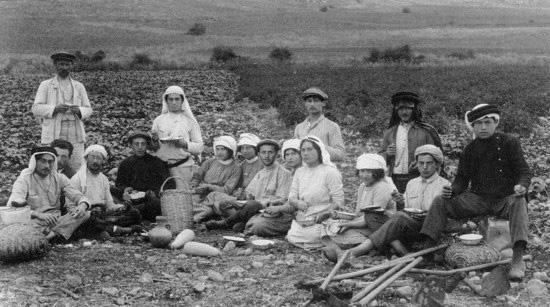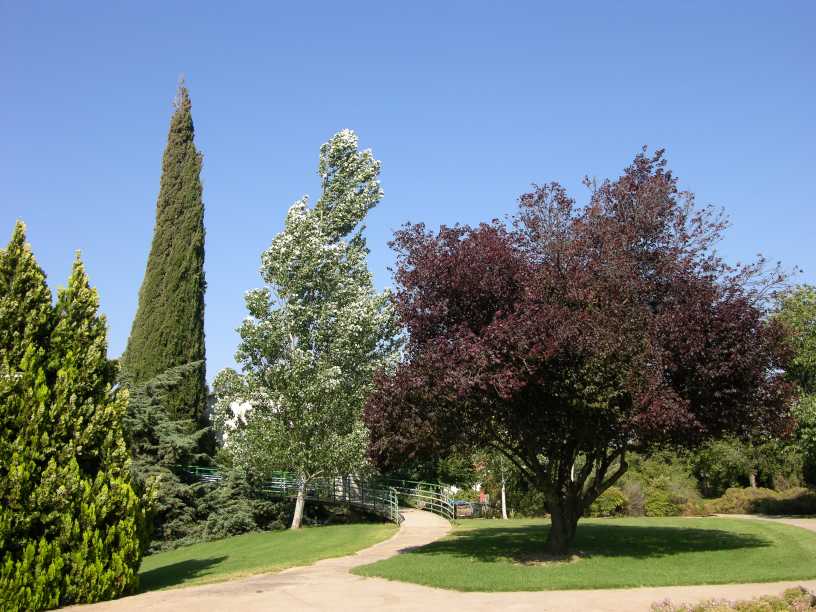|
Hatzerim
Hatzerim (, ''lit.'' Farmyards) is a kibbutz located 8 kilometers west of Beersheba in the Negev desert in Israel. It is named after the Bible (Deuteronomy 2:23), mentioning a site nearby: "the Avvites who lived in farmyards as far as Gaza". It belongs to the Bnei Shimon Regional Council. In it had a population of . History The community was established in October 1946 by a young group of Israel Boy and Girl Scouts Federation, scouts who were then later joined by Polish-Jewish refugees from the Soviet Union; they reached Israel via Iran with the Polish Land Forces, Polish Army, referred to as "The Children of Tehran" ("Dzieci Teheranu" in Polish). They then learned agriculture and military training becoming part of the Haganah ground forces. In the 1960s, the Hatzerim Airbase was built nearby. Hatzerim is now a well developed kibbutz (one of Israel's richest) due to the profits from Netafim. The kibbutz has amenities such as a library, swimming pool, dentist and a zoo. Netaf ... [...More Info...] [...Related Items...] OR: [Wikipedia] [Google] [Baidu] |
Hatzerim Airbase
Hatzerim Airbase (, ''Basis Heil HaAvir Hatzerim'', ''lit.'' Homesteads) is an Israeli Air Force, Israeli Air Force (IAF) base on the northern edge of the Negev, Negev desert in the Southern District (Israel), Southern District of Israel, 6 km west of Beersheba, near kibbutz Hatzerim. Apart from operational fighter jets, it houses the Israeli Air Force Flight Academy, IAF Flight Academy, the IAF Aerobatic Team and – adjacent to the airbase – the Israeli Air Force Museum, IAF Museum (see map). History Hatzerim Airbase was constructed during the 1960s and declared operational on 3 October 1966. It was the first IAF base built from the ground up, as a new base for the IAF, and not on existing base areas of the Royal Air Force. From 1968 to 2015 there was a helicopter squadron here, most recently with Sikorsky UH-60 Black Hawk, UH-60 Black Hawk, which then moved to Palmachim Airbase. From 1969 until today there's the 102 Squadron (Israel), "Flying Tiger" Squadron with je ... [...More Info...] [...Related Items...] OR: [Wikipedia] [Google] [Baidu] |
Hatzerim Iii
Hatzerim (, ''lit.'' Farmyards) is a kibbutz located 8 kilometers west of Beersheba in the Negev desert in Israel. It is named after the Bible (Deuteronomy 2:23), mentioning a site nearby: "the Avvites who lived in farmyards as far as Gaza". It belongs to the Bnei Shimon Regional Council. In it had a population of . History The community was established in October 1946 by a young group of scouts who were then later joined by Polish-Jewish refugees from the Soviet Union; they reached Israel via Iran with the Polish Army, referred to as "The Children of Tehran" ("Dzieci Teheranu" in Polish). They then learned agriculture and military training becoming part of the Haganah ground forces. In the 1960s, the Hatzerim Airbase was built nearby. Hatzerim is now a well developed kibbutz (one of Israel's richest) due to the profits from Netafim. The kibbutz has amenities such as a library, swimming pool, dentist and a zoo. Netafim Hatzerim was one of the first kibbutzim (pl.) to break ... [...More Info...] [...Related Items...] OR: [Wikipedia] [Google] [Baidu] |
Netafim
Netafim is a manufacturer of irrigation equipment owned by Orbia Group. The company produces drippers, dripperlines, sprinklers and micro-emitters. Netafim also manufactures and distributes crop management technologies, including monitoring and control systems, dosing systems, and crop management software, as well as a variety of services, including managed irrigation, agronomical advisory and operation and maintenance. As of 2012, Netafim was the global leader on the fast expanding market of drip- and micro-irrigation.Drip Irrigation Expanding Worldwide National Geographic, 25 June 2012, accessed 1 August 2019 In it was the overall largest provider of systems, with a global m ... [...More Info...] [...Related Items...] OR: [Wikipedia] [Google] [Baidu] |
Kibbutzim
A kibbutz ( / , ; : kibbutzim / ) is an intentional community in Israel that was traditionally based on agriculture. The first kibbutz, established in 1910, was Degania. Today, farming has been partly supplanted by other economic branches, including industrial plants and high-tech enterprises. Kibbutzim began as utopian communities, a combination of socialism and Zionism. In recent decades, some kibbutzim have been privatized and changes have been made in the communal lifestyle. A member of a kibbutz is called a ''kibbutznik'' ( / ; plural ''kibbutznikim'' or ''kibbutzniks''), the suffix ''-nik'' being of Slavic origin. In 2010, there were 270 kibbutzim in Israel with a total population of 126,000. Their factories and farms account for 9% of Israel's industrial output, worth US$8 billion, and 40% of its agricultural output, worth over US$1.7 billion. Some kibbutzim had also developed substantial high-tech and military industries. For example, in 2010, Kibbutz Sasa, co ... [...More Info...] [...Related Items...] OR: [Wikipedia] [Google] [Baidu] |
Kibbutz
A kibbutz ( / , ; : kibbutzim / ) is an intentional community in Israel that was traditionally based on agriculture. The first kibbutz, established in 1910, was Degania Alef, Degania. Today, farming has been partly supplanted by other economic branches, including Factory, industrial plants and high-tech Business, enterprises. Kibbutzim began as utopian communities, a combination of socialism and Zionism. In recent decades, some kibbutzim have been Privatization, privatized and changes have been made in the communal lifestyle. A member of a kibbutz is called a ''kibbutznik'' ( / ; plural ''kibbutznikim'' or ''kibbutzniks''), the suffix ''-nik'' being of Slavic languages, Slavic origin. In 2010, there were 270 kibbutzim in Israel with a total population of 126,000. Their factories and farms account for 9% of Israel's industrial output, worth US$8 billion, and 40% of its agricultural output, worth over US$1.7 billion. Some kibbutzim had also developed substantial high-tech and mi ... [...More Info...] [...Related Items...] OR: [Wikipedia] [Google] [Baidu] |
Beersheba
Beersheba ( / ; ), officially Be'er-Sheva, is the largest city in the Negev desert of southern Israel. Often referred to as the "Capital of the Negev", it is the centre of the fourth-most populous metropolitan area in Israel, the eighth-most populous Israeli city with a population of , and the second-largest city in area (after Jerusalem), with a total area of 117,500 dunams (45 mi2 / 117.5 km2). Human habitation near present-day Beersheba dates back to the fourth millennium BC. In the Bible, Beersheba marks the southern boundary of ancient Israel, as mentioned in the phrase " From Dan to Beersheba." Initially assigned to the Tribe of Judah, Beersheba was later reassigned to Simeon. During the monarchic era, it functioned as a royal city but eventually faced destruction at the hands of the Assyrians. The Biblical site of Beersheba is Tel Be'er Sheva, lying some 2.5 miles (4km) distant from the modern city, which was established at the start of the 20th century by ... [...More Info...] [...Related Items...] OR: [Wikipedia] [Google] [Baidu] |
Bnei Shimon Regional Council
The Bnei Shimon Regional Council (, ''Mo'atza Azorit Bnei Shim'on'', ''lit.'' Regional Council 'Sons of Shimon'), is a regional council in the northern Negev in the south of Israel. Most of its territory lies north of Beersheba and the rest bounds Beersheba on the west and east sides as well. The eastern border of this territory straddles the Green Line. It is named after the tribe of Shimon which had been allotted this region according to the Book of Joshua (19:1-9). There are 13 communities, including seven kibbutzim, four moshavim, and two new rural towns. Four of the communities (three kibbutzim and one moshav) were established in the founding of the ' 11 points in the Negev' in 1946. The rest of the kibbutzim and moshavim were set up after the establishment of the State of Israel. Settlements Kibbutzim * Beit Kama (1949) * Dvir * Hatzerim (1946) * Kramim * Lahav * Mishmar HaNegev (1946) * Shoval (1946) * Shomria (1985/2006) - former kibbutz that was modified for set ... [...More Info...] [...Related Items...] OR: [Wikipedia] [Google] [Baidu] |
Jojoba Oil
Jojoba oil () is the liquid produced in the seed of the ''Simmondsia chinensis'' ( jojoba) plant, a shrub, which is native to southern Arizona, southern California, and northwestern Mexico. The oil makes up approximately 50% of the jojoba seed by weight. The terms "jojoba oil" and "jojoba wax" are often used interchangeably because the wax visually appears to be a mobile oil, but as a wax it is composed almost entirely (~97%) of mono-esters of long-chain fatty acids ''(wax ester)'' and alcohols ( isopropyl jojobate), accompanied by only a tiny fraction of triglyceride esters. This composition accounts for its extreme shelf-life stability and extraordinary resistance to high temperatures, compared with true vegetable oils. History The O'odham Native American tribe extracted the oil from jojoba seeds to treat sores and wounds. The collection and processing of the seed from naturally occurring stands marked the beginning of jojoba domestication in the early 1970s. In 1943, natu ... [...More Info...] [...Related Items...] OR: [Wikipedia] [Google] [Baidu] |
Multinational Corporation
A multinational corporation (MNC; also called a multinational enterprise (MNE), transnational enterprise (TNE), transnational corporation (TNC), international corporation, or stateless corporation, is a corporate organization that owns and controls the production of goods or services in at least one country other than its home country. Control is considered an important aspect of an MNC to distinguish it from international portfolio investment organizations, such as some international mutual funds that invest in corporations abroad solely to diversify financial risks. Most of the current largest and most influential companies are Public company, publicly traded multinational corporations, including Forbes Global 2000, ''Forbes'' Global 2000 companies. History Colonialism The history of multinational corporations began with the history of colonialism. The first multinational corporations were founded to set up colonial "factories" or port cities. The two main examples were the ... [...More Info...] [...Related Items...] OR: [Wikipedia] [Google] [Baidu] |
Yiftach
Yiftah () is a kibbutz in northern Israel. Located near the Lebanese border and the city of Kiryat Shmona, it falls under the jurisdiction of Upper Galilee Regional Council. In it had a population of . History Yiftah was established on 18 August 1948 by demobilised Palmach soldiers who were members of the Yiftach Brigade, after which the kibbutz is named. Metzudat Koach is located nearby. Yiftah is located near Jahula, but on the land belonging to the depopulated Palestinian village of Qadas. During the Gaza war, northern Israeli border communities, including Yiftah, faced targeted attacks by Hezbollah and Palestinian factions based in Lebanon, and were evacuated. On 5 November 2023, a driver operating an Israeli water tank for the IDF was killed by an anti-tank missile An anti-tank guided missile (ATGM), anti-tank missile, anti-tank guided weapon (ATGW) or anti-armor guided weapon is a missile guidance, guided missile primarily designed to hit and destroy armoured ... [...More Info...] [...Related Items...] OR: [Wikipedia] [Google] [Baidu] |





